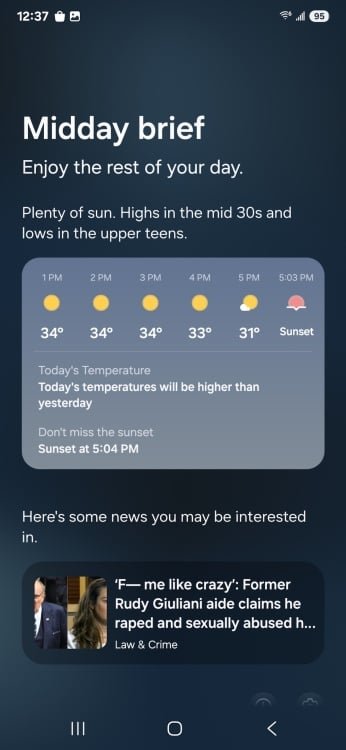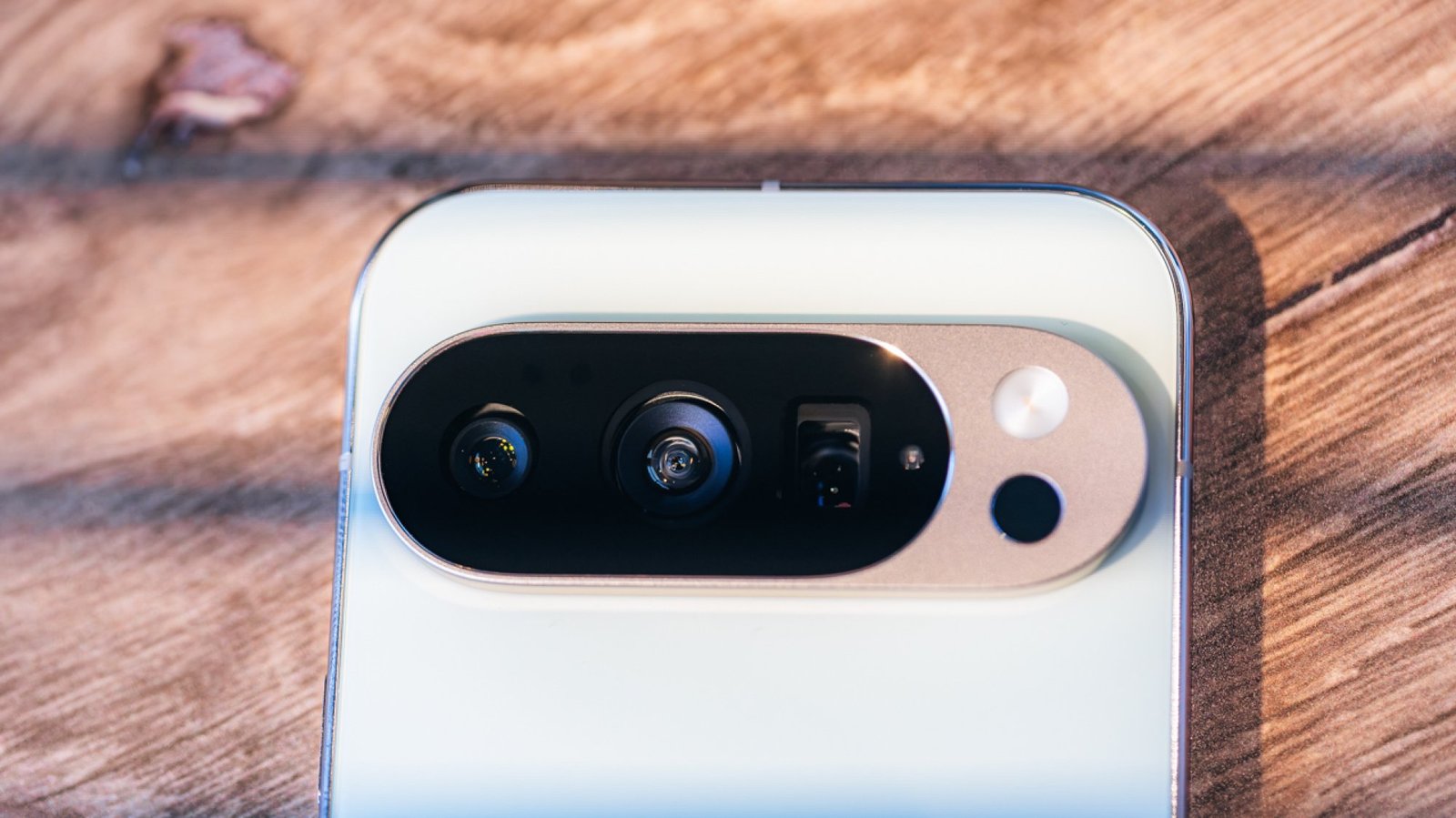Top Stories
Comparing Google Pixel 10 Pro vs. Samsung Galaxy S25 Ultra

In the market for a new, premium Android smartphone? Luckily, there are some heavy-hitting options for you.
Namely, the Google Pixel 10 Pro and the Samsung Galaxy S25 Ultra. The former just hit the scene thanks to the big Made by Google event, while the latter’s been on store shelves since January. Rather than sitting here and establishing more context, though, let’s just jump right into the comparison so you can figure out which flagship appeals to you more.
Google vs. Samsung: The Pixel 10 Pro has the better price
Not a very exciting range of colors this year.
Credit: Joe Maldonado/Mashable
Many of the differences between these two phones will come down to personal preference and will contain a decent amount of nuance. Price is not one of them.
The Google Pixel 10 Pro starts at $999 while the Samsung Galaxy S25 Ultra starts at $1,299. Perhaps the rest of this article will help you understand why Samsung’s handset is more expensive, but the fact of the matter is that going with Google will save a bit of money.
Design: Neither phone is winning design awards

The S25 Ultra has an impressive camera array.
Credit: Joe Maldonado/Mashable

The signature camera bump on the Pixel 10 Pro.
Credit: Joe Maldonado/Mashable
Ultimately, these are both smartphones, meaning they both look like smartphones. There’s only so much that can be done within that framework, in terms of physical design. That said, both Samsung and Google have their own unique design languages that are worth talking about here.
The Galaxy S25 Ultra made a huge improvement over its predecessor by including rounded edges on the phone’s frame, though they are notably still more angular than the Pixel 10 Pro. The arrangement of the rear camera modules accounts for the biggest design change between these two phones, of course. Samsung lets its triple-lens array float freely without any kind of housing or camera bump, instead opting to just let the three lenses sit on top of one another. Google, on the other hand, still uses the same horizontal camera bar for its three lenses, which makes the phone look kinda like Cyclops from X-Men.
Samsung will pretty much always “win” when it comes to color options, too, just because it usually offers a lot more to choose from. The Galaxy S25 comes in seven colors: Titanium Jadegreen, Titanium Jetblack, Titanium Pinkgold, Titanium Black, Titanium Gray, Titanium Silverblue, and Titanium Whitesilver. It should be noted that the first three colors in that list are only available online.
Meanwhile, the Pixel 10 Pro comes in four hues: Moonstone, Jade, Porcelain, and Obsidian.
Which flagship has better specs? Samsung.

S25 Ultra does have a nice display.
Credit: Joe Maldonado/Mashable
Phones are for using and not for looking at, so let’s talk specs. Here are the basic specs for the Pixel 10 Pro:
And here are the equivalent specs for Galaxy S25 Ultra:
There are obviously a few things to discuss here. The S25 Ultra is a much bigger phone than the Pixel 10 Pro, with a higher resolution display and a bigger battery. It’s actually closer to the $1,199 Pixel 10 Pro XL in these respects, perhaps making that phone a more directly comparable device. Having said that, it’s a clear advantage for Google that a smaller, cheaper version of its Pro phone exists at all.
Mashable Light Speed
That allows Google to offer a 128GB storage option for those who want it, but it also means the display and battery are smaller. Life is all about compromises. Interestingly, Google’s phone has more RAM, regardless of size. There are no benchmarks out there yet for the Tensor G5 chip, though if previous years are any indication, it will probably not score as well as the Snapdragon 8 Elite chip. That doesn’t mean the Pixel 10 Pro will have markedly worse performance, though. In my experience, they’re usually pretty comparable.
Samsung actually has one major advantage in this department: an included stylus. The S Pen accessory comes with the S25 Ultra, and the phone has a built-in slot for it. You may or may not be the type of person who wants to use a stylus, but that’s objectively added value over the Pixel 10 Pro.
Google has the edge on AI features

Samsung’s AI daily hub looks like this.
Credit: Screenshot: Samsung
Now that we’re a few years into the whole “every phone has AI features” trend, the differences between devices are starting to get a little more blurry. Both of these handsets are marketed as “AI smartphones.”
To succinctly sum up these two phones in particular, the Pixel 10 Pro’s biggest new AI features are meant to play catch-up with Samsung and other competitors. That’s not hard for Google, which has a full suite of AI tools powered by Gemini. And since the Pixel 10 Pro comes with a free year of Google AI Pro (if you purchase at the Pixel store, at least), Google may have the edge.
Namely, the Pixel 10 Pro has live language translation during phone calls, theoretically enabling seamless vocal communication across language barriers (we’re still testing the Pixel 10 series). The Galaxy S25 Ultra could already do this in January, though Google samples your voice for a more natural conversation and performs the translation on your device for privacy. Google also added Daily Hub, a new one-stop-shop for your daily schedule, weather forecast, to-do list, and relevant news. Samsung, believe it or not, also had that earlier this year.
Google does have some advantages in terms of AI photo editing. Pixel 10 Pro can edit photos based on text prompts, in case your ability to describe things is stronger than your editing finger. Camera Coach is also an intriguing new feature that can potentially teach you how to properly compose photos. Aside from that, many of the AI editing features across both of these phones are pretty similar.
We also have to mention Google’s new Magic Cue tool. It’s an AI assistant that finds information from apps like Gmail, Calendar, Screenshots, and Messages so it can automatically make recommendations. Texting someone about a dinner reservation? Magic Cue will pull up the booking and add a link to the text for you.
Pixel 10 Pro vs. Galaxy S25 Ultra: Which phone has the best camera?

Yep, still looks like Cyclops.
Credit: Joe Maldonado/Mashable
Which flagship is better for photography? We can’t render a verdict just yet.
At Made by Google, the company claimed the Pixel 10 Pro has the best camera on any phone in the world. While the S25 Ultra offers a way higher megapixel count on its main rear camera, the Pixel 10 Pro supposedly closes the gap with strong AI zoom, high-quality nighttime photography, and motion stabilization for video.
The Pixel 10 Pro’s camera specs are as follows:
And here’s what you get with Galaxy S25 Ultra:
It’s also worth mentioning that both phones now offer up to 100x digital zoom, though it remains to be seen how well it works on Pixel 10 Pro. On Galaxy S25 Ultra, it’s pretty obvious that the phone is doing some digital trickery to fill in the blanks.
Regardless, 200MP vs. 50MP for the main rear lens is a pretty stark difference, although we need to do detailed testing to see if it manifests in a meaningful way. The Pixel 10 Pro might make up for that with a 42MP selfie cam, depending on how much you like taking selfies.
At the end of the day, you’re probably going to be able to take pretty good pictures of your pets and/or meals for Instagram, no matter which phone you choose.
Top offers on Pixel 10 and S25 Ultra:



Top Stories
NFL Week 2 news, scores and highlights

The Jets and Bills are each coming off thrilling opening games.
New York narrowly lost to Pittsburgh and Buffalo mounted an improbable comeback against the Ravens. In a bright spot for the Jets, star wide receiver Garrett Wilson seemed to form chemistry with Justin Fields, catching seven passes for 95 yards and a touchdown.
Can the Jets build upon the positives from Week 1? Or will Josh Allen and Co. be too much firepower for New York to keep up with?
Follow The Post’s live updates for the latest Jets-Bills score, news and highlights.
Top Stories
Demon Slayer Global Box Office, Conjuring & Downton Abbey: Grand Finale

Refresh for latest… It was only a matter of time, and what a time it is. After making record-breaking waves in Japan this summer, and rolling out in staggered fashion elsewhere, Demon Slayer: Kimetsu no Yaiba Infinity Castle finally reached a big suite of overseas markets, and the U.S., this weekend via Sony/Crunchyroll.
The latter are reporting a new high for the biggest anime opening of all time with a $132.1M global weekend. That breaks down to $70M in North America, plus $29M from Latin America, $17.4M from Europe, $6M from Middle East, $5.2M from India and $3.2M from Australia as well as some smaller markets.
Note that, along with Japan, Sony does not have Korea, Taiwan or China. In Korea, Infinity Castle is already at $34.7M through today, and is the No. 3 movie of the year in the market.
We saw a phenomenon with Demon Slayer: Mugen Train in 2021, and this continuation just drives home how popular the genre has become.
Breaking down the results via Sony, Latin America scored the No. 1 anime opening of all time in multiple markets including Mexico ($9.8M), Brazil ($4.4M), Peru ($2.8M), Central America ($2.4M), Argentina ($2.2M), and Chile ($2.2M).
In Europe and the Middle East, key markets that opened as the top anime film ever include: UK ($4.6M), Spain ($3.7M), Italy ($3.M), Saudi Arabia ($2.8M) and the UAE ($1.4M).
Elsewhere, India launched to $5.2M for the biggest opening weekend of any anime or animation film. Australia kicked off with $3.2M, the highest opening for an anime movie.
In Japan, this is a Toho/Aniplex release from Ufotable. By last weekend’s count, it had already exceeded $282M in the home market and a handful of others. With Sony’s reported take this frame, that would lift the movie well above the four-century mark.
I need to codicil, as per usual, that official numbers out of Japan are not reliable until the Monday, but we are certainly in the ballpark here.
Either way, what a great result that expands theatrical audiences.
The Top 5 for Sony/Crunchyroll markets overseas are: Hong Kong ($11.7M), Indonesia ($7.2M), Thailand ($7M), Malaysia ($6.5M), #1 all-time anime) and Philippines ($6.4M). Many of those are all-timers for anime.
Still to come are French-speaking and German-speaking markets next weekend.
After last weekend’s divine opening, New Line/Warner Bros’ The Conjuring: Last Rites added a big $60.5M in 76 markets during the sophomore session. The international running cume has crossed the $200M mark at $201.8M. Global is $332.9M through Sunday.
New starts this frame included France and Belgium as the top openings ever for the franchise, while the Miiddle East opened as the biggest opening weekend ever for a horror title.
Overall, holds were strong. Among Latin America markets, Last Rites has already become the biggest industry horror movie in Peru, Guatemala, Nicaragua and Uruguay. Asia also leaned in with Last Rites the No. 1 movie again in Indonesia, Philippines, Thailand and Malaysia.
Japan is still to open, on October 17.
Univeral/Focus’ return/goodbye to Highclere Castle has stuck a chord with audiences. Downton Abbey: The Grand Finale released in just 31 international box office markets and grossed $12.3M; abovet the last entry in the feature series, Downton Abbey: A New Era, and in line with Ticket to Paradise at the same point. The global start was $30.4Mx.
Natch, the UK was the biggest Downton market this weekend at at clear No.1and with $6.3M; it outgrossed the three-day opening weekend of Downton Abbey: A New Era in just its first two days of release.
France has a terrific $1.4M bow across 423 screens at No.2in the market, behind fellow opener Conjuring: Last Rites. Performance is above Downton Abbey: A New Era and Ticket to Paradise at the same point, and play is seen in commercial and arthouse cinemas.
In Australia, Downton Abbey: The Grand Finale added $1.2M in its opening weekend, across 314 screens at No.3 in the market, behind Demon Slayer and The Conjuring: Last Rites. An opening of this level is in line with Downton Abbey: A New Era. Reviews in the market have been overwhelmingly positive.
The Netherlands achieved the highest opening weekend of the franchise, as well asthe biggest day in the franchise’s history on Saturday. The weekend grossed $900K, above both Downton Abbey and Downton Abbey: A New Era and in line with Ticket to Paradise.
Italy grossed $500K in its opening weekend across 350 screens at No.4 in the market, behind Demon Slayer, Conjuring: Last Rites and Materialists. Performance is above Downton Abbey: A New Era at the same point.
Next markets ahead include Germany, Mexico, Span and Japan.
Top Stories
How much freedom of speech do you have at work? Experts weigh in after Charlie Kirk’s death

NEW YORK (AP) — In the days following the fatal shooting of conservative activist Charlie Kirk, numerous workers have been fired for their comments on his death, among them MSNBC political analyst Matthew Dowd.
Several conservative activists have sought to identify social media users whose posts about Kirk they viewed as offensive or celebratory, targeting everyone from journalists to teachers. Right-wing influencer Laura Loomer said she would try to ruin the professional aspirations of anyone who celebrated Kirk’s death.
It’s far from the first time workers have lost their jobs over things they say publicly — including in social media posts. But the speed at which the firings have been happening raises questions about worker rights versus employer rights.
In the U.S., laws can vary across states, but overall, there’s very little legal protections for employees who are punished for speech made both in and out of private workplaces.
“Most people think they have a right to free speech…but that doesn’t necessarily apply in the workplace,” said Vanessa Matsis-McCready, associate general counsel and vice president of HR Services for Engage PEO. “Most employees in the private sector do not have any protections for that type of speech at work.”
Add to that the prevalence of social media, which has made it increasingly common to track employees’ conduct outside of work and to dox people, or publish information about them online with the intent of harming or harassing them.
Employers have a lot of leeway
Protections for workers vary from one state to the next. For example, in New York, if an employee is participating in a weekend political protest, but not associating themselves with the organization that employs them, their employer cannot fire them for that activity when they return to work.
But if that same employee is at a company event on a weekend and talks about their political viewpoints in a way that makes others feel unsafe or the target of discrimination or harassment, then they could face consequences at work, Matsis-McCready said.
Most of the U.S. defaults to “at-will” employment law — which essentially means employers can choose to hire and fire as they see fit, including over employees’ speech.
“The First Amendment does not apply in private workplaces to protect employees’ speech,” said Andrew Kragie, an attorney who specializes in employment and labor law at Maynard Nexsen. “It actually does protect employers’ right to make decisions about employees, based on employees’ speech.”
Kragie said there are “pockets of protection” around the U.S. under various state laws, such as statutes that forbid punishing workers for their political views. But the interpretation of how that gets enforced changes, he notes, making the waters murky.
Steven T. Collis, a law professor at the University of Texas at Austin and faculty director of the school’s Bech-Loughlin First Amendment Center, also points to some state laws that say employers can’t fire their workers for “legal off duty conduct.” But there’s often an exception for conduct seen as disruptive to an employer’s business or reputation, which could be grounds to fire someone over public comments or social media posts.
“In this scenario, if somebody feels like one of their employees has done something that suggests they are glorifying or celebrating a murder, an employer might still be able to fire them even with one of those laws on the books,” Collis said.
For public employees, which can range from school teachers and postal workers to elected officials, the process is a bit different. That’s because the First Amendment plays a unique role when the government is the employer, Collis explains. The Supreme Court has ruled that if an employee is acting in a private capacity but speaking on a matter of public concern, they could be protected. Still, he noted that government employers can discipline a worker if they determine such conduct will interfere with the government’s ability to do its job.
Some in the public sector have already worked to restrict speech in the aftermath of Kirk’s death. For instance, leaders at the Pentagon unveiled a “zero tolerance” policy for any posts or comments from troops that make light of or celebrate the killing of Kirk.
The policy, announced by the Pentagon’s top spokesman Sean Parnell on social media Thursday, came hours after numerous conservative military influencers and activists began forwarding posts they considered problematic to Parnell and his boss, defense secretary Pete Hegseth.
“It is unacceptable for military personnel and Department of War civilians to celebrate or mock the assassination of a fellow American,” Parnell wrote Thursday.
A surge of political debate
The ubiquity of social media is making it easier than ever to share opinions about politics and major news events as they’re unfolding. But posting on social media leaves a record, and in times of escalating political polarization, those declarations can be seen as damaging to the reputation of an individual or their employer.
“People don’t realize when they’re on social media, it is the town square,” said Amy Dufrane, CEO of the Human Resource Certification Institute. “They’re not having a private conversation with the neighbor over the fence. They’re really broadcasting their views.”
Political debates are certainly not limited to social media and are increasingly making their way into the workplace as well.
“The gamification of the way we communicate in the workplace, Slack and Teams, chat and all these things, they’re very similar to how you might interact on Instagram or other social media, so I do think that makes it feel a little less formal and somebody might be more inclined to take to take a step and say, ‘Oh, I can’t believe this happened,’” Matsis-McCready said.
Employers are not ready
In the tense, divided climate of the U.S., many human resource professionals have expressed that they’re unprepared to address politically charged discussions in the workplace, according to the Human Resource Certification Institute. But those conversations are going to happen, so employers need to set policies about what is acceptable or unacceptable workplace conduct, Dufrane said.
“HR has got to really drill down and make sure that they’re super clear on their policies and practices and communicating to their employees on what are their responsibilities as an employee of the organization,” Dufrane said.
Many employers are reviewing their policies on political speech and providing training about what appropriate conduct looks like, both inside and outside the organization, she said. And the brutal nature of Kirk’s killing may have led some of them to react more strongly in the days that followed his death.
“Because of the violent nature of what some political discussion is now about, I think there is a real concern from employers that they want to keep the workplace safe and that they’re being extra vigilant about anything that could be viewed as a threat, which is their duty,” Matsis-McCreedy said.
Employees can also be seen as ambassadors of a company’s brand, and their political speech can dilute that brand and hurt its reputation, depending on what is being said and how it is being received. That is leading more companies to act on what employees are saying online, she said.
“Some of the individuals that had posted and their posts went viral, all of a sudden the phone lines of their employers were just nonstop calls complaining,” Matsis-McCready said.
Still, experts like Collis don’t anticipate a significant change in how employers monitor their workers speech — noting that online activity has come under the spotlight for at least the last 15 years.
“Employers are already and have been for a very long time, vetting employees based on what they’re posting on social media,” he said.
____
Associated Press Staff Writer Konstantin Toropin in Washington contributed to this report.
-

 Business2 weeks ago
Business2 weeks agoThe Guardian view on Trump and the Fed: independence is no substitute for accountability | Editorial
-
Tools & Platforms1 month ago
Building Trust in Military AI Starts with Opening the Black Box – War on the Rocks
-

 Ethics & Policy2 months ago
Ethics & Policy2 months agoSDAIA Supports Saudi Arabia’s Leadership in Shaping Global AI Ethics, Policy, and Research – وكالة الأنباء السعودية
-

 Events & Conferences4 months ago
Events & Conferences4 months agoJourney to 1000 models: Scaling Instagram’s recommendation system
-

 Jobs & Careers3 months ago
Jobs & Careers3 months agoMumbai-based Perplexity Alternative Has 60k+ Users Without Funding
-

 Podcasts & Talks2 months ago
Podcasts & Talks2 months agoHappy 4th of July! 🎆 Made with Veo 3 in Gemini
-

 Education3 months ago
Education3 months agoVEX Robotics launches AI-powered classroom robotics system
-

 Education2 months ago
Education2 months agoMacron says UK and France have duty to tackle illegal migration ‘with humanity, solidarity and firmness’ – UK politics live | Politics
-

 Funding & Business3 months ago
Funding & Business3 months agoKayak and Expedia race to build AI travel agents that turn social posts into itineraries
-

 Podcasts & Talks2 months ago
Podcasts & Talks2 months agoOpenAI 🤝 @teamganassi

